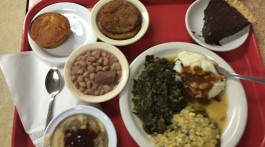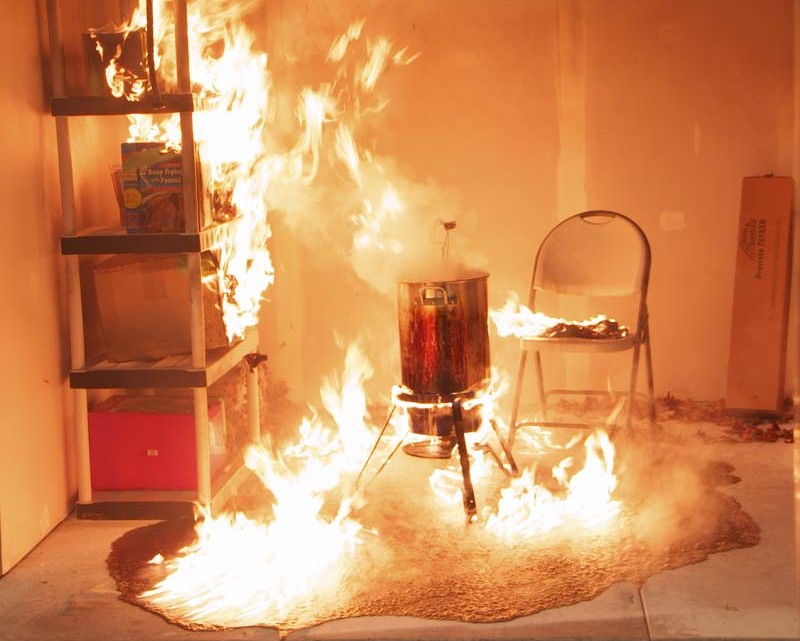What I’m about to say is a direct challenge to the man-cooking orthodoxy.
To be clear, I believe my bona fides when it comes to complicated and potentially dangerous cookery are not in question. Two of my favorite kitchen tools are a plumbing torch and a large wooden hammer. I’ve stayed up all night cooking whole animals on hardwood and tempted botulism with ridiculously long sous-vide times. If there’s a more expensive and obnoxious way to cook something, I’m usually willing to give it a try.
But one Mad Bomber-level cooking project has become a thing on Thanksgiving, with giant piles of cheap equipment popping up in every Lowe’s and Home Depot in America come November. And I’m here to start pushing back.
Friends, we have to stop deep-frying turkeys.
*****
My reasoning here is threefold.
It isn’t really that much better
“But deep-fried turkey is so juicy!” you’re saying. And you’re not wrong. I will stipulate that the average deep-fried turkey is better than the average oven-cooked turkey, but that says more about our collective roasting skills than anything else. It isn’t the deep-frying that keeps the turkey moist; it’s the step you have to take before the fry that does the trick.
It’s pulling out that damned pop-up thermometer.
I’m talking about the plastic thing they stick in just about every commercially-available turkey that pops up when the bird is “done”. And that’s true, if by “done” you mean “beyond all hope”. The best way to get dry white meat is to overcook it, and that little plastic tab is a pretty reliable indicator that you’ve done so. (1)
But you can’t deep-fry a bird with plastic stuck in it, so it’s the first thing to go before the bird hits the oil. So people who fry turkeys are forced to use a thermometer to check for doneness, and 99% of the time that means it’s going to get pulled out much closer to the right time. Even those who shun measurements and rely on a time-and-weight chart (a bad idea, by the way) are probably getting a better bird.
So if it’s juicy turkey you want, ignore the pop-up and invest in either an instant-read or a leave-in probe thermometer. The Thermapen is the Cadillac of instant reads, and the one I use, but more casual users will get along fine with the Thermopop or this cheap model from Taylor. (2)
(Also: “low-and-slow” cooking is another enemy of quality turkey. Crank that oven up. Nothing under 350.)
It misses the whole point of deep-frying
Let’s say you ordered some fried chicken, and the restaurant just took a whole, unbreaded chicken, dropped it in the deep fryer, and then cut off your order and served it up. You’d be confused and disappointed, right?
That’s because the magic of deep-frying happens on the surface. It’s about creating that golden brown and delicious crust on a breaded piece of chicken or fish, or crisping up the outer starch of a French fry. Most of us are indifferent to what’s going on in the interior of our deep-fried foods, as long as the outside is done right. (3)
In his 2014 epic Eat More Better, Cooking Channel host (and friend of WCN!) Dan Pashman talks at length about the Surface Area to Volume Ratio, or SATVOR. If it’s the outer surface of a food that we’re interested in, then we want to maximize the SATVOR; that’s why we pound chicken breasts flat to fry them as cutlets, or for that matter the whole reason we cut potatoes into fries.
What shape has the minimum SATVOR for a given volume? The sphere. And a turkey is basically a sphere. So, pound for pound, you’re getting the least possible amount of surface deliciousness when you deep-fry a whole turkey.
There is the issue of crispy turkey skin, and it’s true that a deep-fried turkey can have a beautifully crispy skin if done right. But you can do that in the oven, too:
- Dry-brine your bird.
- Dry the surface of the bird thoroughly with paper towels, then let it air-dry for a bit (or overnight in the fridge if you can) before you cook it.
- Rub the skin with a little olive oil or butter.
- Cook it hot for the first 30 minutes–425-450 or so.
- Probably most importantly–when it’s done, don’t let it sit for long, and don’t tent it with foil. The steam will undo whatever crisping you just did.
No, really, it’s that dangerous
So here’s the scenario–assemble all of your family’s males of age in the garage, including the ones talking at length about their plans to vote for Donald Trump. Add a cooler full of Bud Light. Unpack the $39.95 turkey frying rig that somebody bought somebody for Christmas last year, which consists of a thin aluminum pot and a burner set on rickety legs. Connect it via a cheap hose to a canister containing 25 pounds of highly flammable liquid. Set it aflame, add several gallons of peanut oil, and heat it to 350 degrees according to the kit’s sketchy fry thermometer. Drop in a questionably thawed bird, roughly the weight of a big bowling ball but more awkwardly shaped. Oh, and add all of the nieces and nephews, bored by the lack of entertainment options at Grandma’s house and drawn by the smell to the Forbidden Pot of Mystery. What could possibly go wrong?
A lot, it turns out. Call any fire department or emergency room, or tune in any local newscast during the slowest news day of Thanksgiving week, and they’ll tell you exactly what can go wrong. For instance, what happens if that turkey isn’t thawed all the way? Something like this:
Lots of people burn their houses down and lots of people get hurt every year trying to deep-fry a turkey. And even if you escape such a mishap without personal injury or property damage, in the best case scenario you’re left turkeyless. Even if a deep fried turkey is marginally better than the oven-roasted version, is it worth that kind of risk?
*****
If you must fry a turkey this year, Alton Brown’s brilliant Turkey Derrick is one way to minimize (but not eliminate) the potential danger. (4) But if such an elaborate rig is necessary to avoid death and dismemberment, in the service of what might be a slightly better bird, maybe it’s time to let the trend pass and focus on how to make a great turkey in the oven.
*****
(1): When Consumer Reports looked into it, most of the pop-ups popped above 165 degrees–which is the minimum safe temperature, but remember that a turkey will carry over by 5-10 degrees, so if you wait until 165 to pull it out it’s going to overcook. And one in seven of the pop-ups deployed under 165 degrees, which means it’s not even a good indicator that you’ve hit the safe temperature. A tool that blunt is worse than useless.
(2): The extra money pays for a faster and more accurate read and a thinner probe, but also for durability. If you use it frequently, you’ll probably have to replace the Taylor every year or so, making the Thermapen more of a bargain in the end. I haven’t used the Thermopop, so I can’t personally say if it’s a good middle ground.
(3): “But what about Buffalo wings?” you ask. “Aren’t they just dumped unbreaded into the deep fryer?” True, but keep in mind that chicken wings have a pretty high SAVR, so it’s not an unreasonable way to crisp up the skin. But wings are just as good done in the oven, IMO.
(4): We got to see Alton’s first public demonstration of the Derrick at the Opryland Hotel many years ago, before the Good Eats episode about it aired. The presentation included a slide show of turkey fryer disaster photos.








No Comment